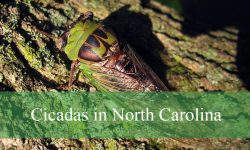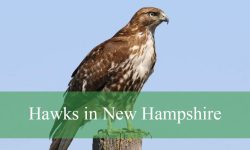Massachusetts is home to several species of falcons, each with unique characteristics, behaviors, and habitats. These raptors range from small to medium size and are renowned for their speed, agility, and precise hunting skills. Watching falcons in the wild provides a fascinating insight into the state’s diverse birdlife.
Falcons are highly adaptable hunters, thriving in a variety of environments including woodlands, open fields, coastal areas, and even urban landscapes. Their remarkable flight abilities and keen eyesight make them effective predators and a favorite among birdwatchers.
In this article, we will explore the four main falcon species found in Massachusetts: the American Kestrel, Merlin, Peregrine Falcon, and the rare Gyrfalcon. Each section includes detailed information on identification, size, behavior, habitat, and the best times and locations to observe these magnificent birds.
Common Falcons Found in Massachusetts
American Kestrel (Falco sparverius)
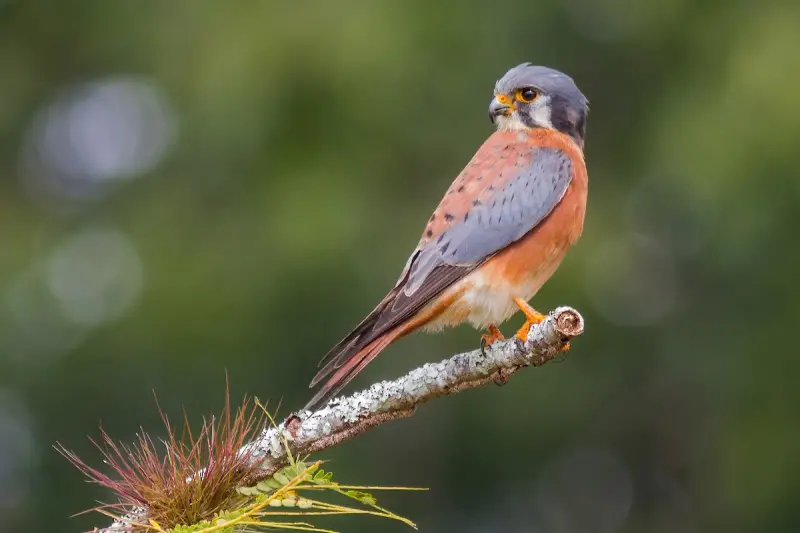
The American Kestrel is the smallest falcon in North America, measuring 8–12 inches in length with a wingspan of 20–24 inches. Males exhibit striking coloration with slate-blue wings, rusty-red backs, and bold black facial markings, including a vertical stripe beneath the eyes and a horizontal “moustache” line. Females are more uniformly reddish-brown with heavy streaking on the underparts and lack the vibrant blue wing patches seen in males. Both sexes have sharp, hooked beaks, long pointed wings, and a compact, agile body suited for swift hunting. Juveniles resemble females but have paler and less distinct streaking, gradually developing adult plumage over their first year.
American Kestrels are highly skilled hunters, often hovering in midair to survey fields for prey. Their diet mainly consists of insects, small birds, and rodents, which they capture with quick, precise dives. They are also opportunistic feeders, taking advantage of open spaces, roadside perches, and even urban areas to spot and catch prey. Kestrels are known for their agility and precision, frequently performing acrobatic aerial maneuvers while hunting.
In Massachusetts, American Kestrels inhabit open woodlands, grasslands, farmlands, and suburban environments. They are cavity nesters, utilizing tree holes, old woodpecker cavities, and nest boxes installed by humans. Many kestrels remain in the state year-round, though northern populations may migrate southward during the coldest months. They are highly adaptable, able to thrive in both rural and urban landscapes where hunting opportunities and suitable nesting sites are available.
The best times to observe American Kestrels in Massachusetts are early morning and late afternoon, when they are actively hunting or perched on wires, posts, and trees. Central and western Massachusetts, as well as coastal areas with open fields, offer prime observation spots. Their small size, vibrant plumage, hovering behavior, and swift, darting flight make them relatively easy to identify, providing an exciting and rewarding experience for birdwatchers.
Merlin (Falco columbarius)
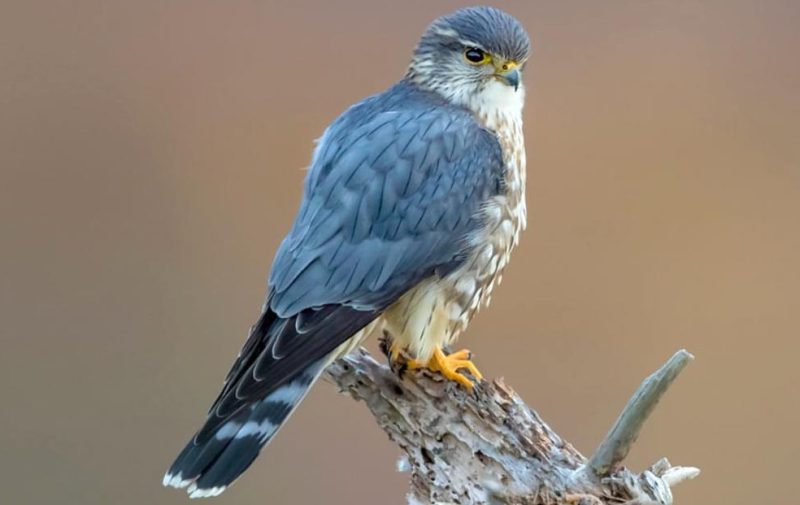
The Merlin is a small but exceptionally powerful falcon, measuring 9–12 inches in length with a wingspan of 20–27 inches. Males are characterized by slate-gray upperparts with subtle streaking on the chest and underparts, while females display warmer brown tones with heavier streaking, giving them a more robust appearance. Both sexes have sharply pointed wings, a relatively short tail, and a compact, stocky body, which helps distinguish them from other small falcons like the American Kestrel. Juvenile Merlins resemble females but have paler plumage and buffy streaks that gradually darken as they mature.
Merlins are aggressive and highly efficient hunters. They specialize in capturing small birds such as sparrows and finches, though they also take insects and occasionally small mammals. Unlike the American Kestrel, which often hovers while hunting, Merlins rely on rapid, low-level aerial chases and surprise attacks, demonstrating remarkable speed, agility, and precision in mid-flight. Their hunting style often involves weaving through dense vegetation or pursuing prey across open fields at astonishing speeds.
In Massachusetts, Merlins are typically found in open woodlands, coastal marshes, fields, and along river corridors. They breed primarily in the northern and western parts of the state, favoring remote areas that provide both cover and hunting grounds. During the winter, many Merlins migrate southward, occasionally reaching more urbanized and coastal areas. They exhibit remarkable adaptability in nesting, often utilizing tree cavities, abandoned hawk nests, cliff ledges, or even tall man-made structures when natural sites are scarce.
The best chances to observe Merlins in Massachusetts are during spring and fall migrations when they are more widely dispersed across the state. Coastal regions, open fields, and forest edges in western Massachusetts provide excellent vantage points. Observers should note their rapid, darting flight patterns, small size, and high-speed hunting techniques, which make them both challenging and rewarding to spot. Merlins are a thrilling species to watch due to their intense energy, swift maneuvers, and striking hunting prowess.
Peregrine Falcon (Falco peregrinus)
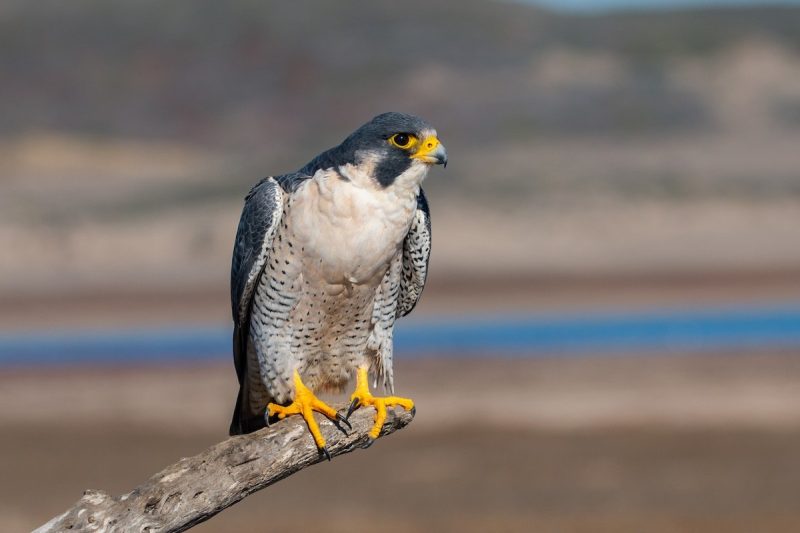
The Peregrine Falcon is a medium-sized raptor, measuring 13–20 inches in length with a wingspan of 34–43 inches. Adults feature slate-gray backs, barred underparts, and a striking black “moustache” mark on the face, which contrasts sharply with their pale throat and cheeks. Their long, pointed wings and streamlined body are perfectly adapted for high-speed flight, making them one of the fastest birds in the world, capable of diving at speeds exceeding 200 mph during hunting stoops. Juveniles have browner plumage with vertical streaks on the chest, gradually developing adult coloration as they mature.
Peregrine Falcons are apex aerial predators, specializing in hunting other birds mid-flight, from pigeons and doves to shorebirds and small songbirds. They rely on high vantage points such as cliffs, tall trees, or urban skyscrapers to survey their territory and launch rapid stoops. Their hunting technique is a combination of stealth, precision, and explosive speed, enabling them to strike prey with incredible force. Highly territorial, Peregrines often return to the same nesting sites year after year, demonstrating strong site fidelity and remarkable memory of their hunting grounds.
In Massachusetts, Peregrine Falcons are commonly found along coastal cliffs, river valleys, and in urban areas where tall buildings mimic natural cliffs. Once endangered due to pesticide contamination, especially from DDT, their populations have rebounded thanks to focused conservation efforts, reintroduction programs, and the installation of nest boxes in cities like Boston and Cambridge. Breeding occurs in spring, with pairs fiercely defending nesting territories, and many Peregrines remain in the state throughout the year rather than migrating.
The best times to observe Peregrines are early mornings and late afternoons when they are actively hunting or soaring along cliffs and urban skylines. Their distinctive pointed wings, powerful flight, and rapid stooping maneuvers make them unmistakable among other raptors. Coastal regions, river corridors, and urban observation points provide ideal locations for birdwatchers seeking to witness the Peregrine’s incredible speed and hunting prowess firsthand.
Gyrfalcon (Falco rusticolus)
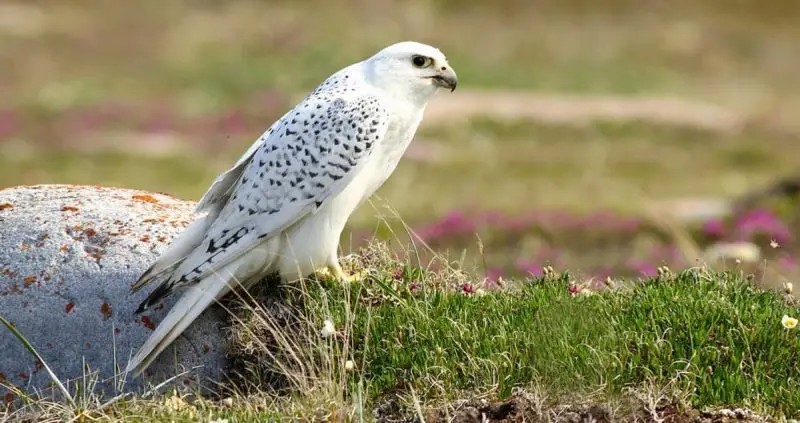
The Gyrfalcon is the largest falcon in North America, measuring 20–26 inches in length with a wingspan of 48–60 inches. Its plumage varies widely, ranging from dark slate-gray to almost pure white, often displaying barred patterns across the chest and wings. These robust birds possess broad, powerful wings, strong talons, and a muscular build, reflecting their specialization in hunting larger prey. Juvenile Gyrfalcons often show darker, more mottled plumage, which gradually lightens as they mature. Their large size, broad wings, and formidable presence make them instantly distinguishable from other falcons in the region.
Gyrfalcons are apex predators, primarily hunting medium to large birds such as ptarmigan, waterfowl, and occasionally small mammals. Adapted to arctic and subarctic climates, they demonstrate incredible endurance and strength, capable of pursuing prey over long distances and in harsh weather conditions. Their hunting techniques include high-speed aerial chases, ambush attacks from elevated perches, and tactical maneuvering to capture swift or evasive prey.
In Massachusetts, Gyrfalcons are extremely rare and appear mostly as winter visitors. They are generally observed along the coast, open fields, and other expansive landscapes where prey is accessible. While more commonly found in northern North America, particularly in Arctic and boreal regions, Gyrfalcons occasionally migrate south during severe winters in search of food. Their presence in Massachusetts is considered a special occurrence and attracts considerable attention from birdwatchers.
The best time to see Gyrfalcons in Massachusetts is during the winter months, especially along coastal areas, open fields, and other large, unobstructed landscapes. Their impressive size, strength, and striking plumage make sightings highly rewarding, though encounters remain infrequent. Observing a Gyrfalcon in Massachusetts offers birdwatchers a rare opportunity to witness one of the most powerful and majestic falcons in North America.
FAQs About Falcons in Massachusetts
Which falcon is the most common in Massachusetts?
The American Kestrel is the most common falcon in the state, widely seen in fields, open woodlands, and suburban areas.
When is the best time to see Peregrine Falcons in Massachusetts?
Early morning and late afternoon, particularly along coastal cliffs and urban centers, are ideal times to observe Peregrine Falcons hunting or flying.
Are Gyrfalcons permanent residents in Massachusetts?
No, Gyrfalcons are rare visitors, mostly seen during the winter months when northern populations move south in search of food.
How can I distinguish a Merlin from an American Kestrel?
Merlins are stockier, have more pointed wings, and are faster in flight. They also prefer aerial chases, while kestrels often hover when hunting.
Where can I see falcons during migration in Massachusetts?
Coastal areas, open fields, and river valleys provide excellent viewing opportunities during spring and fall migrations for Merlins and Peregrine Falcons.





